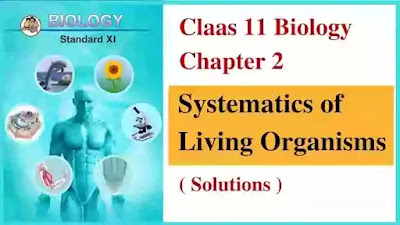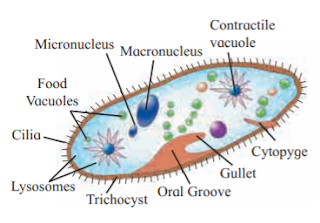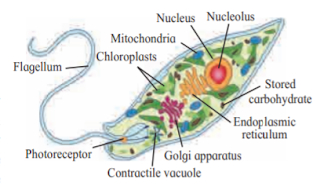Class 11 Biology Chapter 2 Systematics of Living Organisms solutions
Maharashtra state board Biology Textbook Solutions for Class 11 are essential and crucial that help the students in understanding the hard topics and help them in the preparation for the Class 11 board examination as well as various competitive entrance examinations also.
Studying the answers to the questions in the Biology textbook will check your understanding of a particular topic and helps you determine your strengths and weaknesses.

Class 11 Biology Chapter 2 Systematics of Living Organisms solutions Maharashtra state board are provided here with simple step-by-step detailed explanation
These solutions for the Systematics of Living Organisms are very popular among Class 11 students. Systematics of Living Organisms Class 11 Exercise comes in handy for quickly completing your homework and preparing for competitive exams like NEET, CET, and various medical entrance examinations also.
Class 11 Biology Chapter 2 Systematics of Living Organisms solutions
1. Choose the Correct Option
A. Which of the following shows single-stranded RNA and lacks a protein coat?
a. Bacteriophage
b. Plant virus
c. Viroid
d. Animal virus
Answer: C
B. Causative agent of red tide is _____________.
a. Dinoflagellate
b. Euglenoid
c. Chrysophyte
d. Lichen
Answer: A
C. Select the odd one out for Heterotrophic bacteria.
a. Nitrogen fixing bacteria
b. Lactobacilli
c. Methanogens
d. Cyanobacteria
Answer: (c) Methanogens or (d) Cyanobacteria
D. Paramoecium: Ciliated Protist:: :: Plasmodium: ____________
a. Amoeboid protozoan
b. Ciliophora
c. Flagellate protozoan
d. Sporozoan
Answer: D
2. Answer the Following
A. What are the salient features of monera?
Answer: The essential features of Monera include being unicellular, microscopic, and lacking a nucleus or other membrane-bound organelles such as mitochondria.
Salient features of kingdom monera
- Monera kingdom includes prokaryotic organisms.
- organisms of Monera do not contain membrane-bound organelles.
- organisms of Monera lack nuclear envelope & DNA without histone such DNA known as Nucleoid or Genome.
- organisms of Monera may be autotrophic or heterotrophic but most of the members are heterotrophic.
B. What will be the shape of the bacillus and coccus type of bacteria?
Answer: Cocci (or coccus for a single cell) are round cells, sometimes slightly flattened when they are adjacent to one another. Bacilli (or bacillus for a single cell) are rod-shaped bacteria. Spirilla (or spirillum for a single cell) are curved bacteria that can range from a gently curved shape to a corkscrew-like spiral.
C. Why is binomial nomenclature important?
Answer: Binomial nomenclature is the system of naming all living organisms on planet Earth according to their scientific representations. It has two parts genus and epithet.
- It was essential to name animals, plants, or any other living organisms in such a way as to prevent any confusion which was caused before.
- Binomial nomenclature is important because, In this, each organism is given a name containing genus and species which is constant all over the world.
- It is easy to identify and describe any organism by this name without any confusion.
- e.g., Mangifera indica is a scientific name that is constant worldwide.
3. Write Short Notes
A. Useful and harmful bacteria.
Answer: Harmful activities of bacteria are as follows:
- Spoilage of food
- Food poisoning
- Deterioration of domestic articles
- Desulphurification of soils
- Denitrification of soils
- Diseases
- Water pollution
Human Uses of Bacteria
- Fermentation processes, such as brewing, baking, and cheese and butter manufacturing.
- Chemical manufacturing, such as the production of ethanol, acetone, organic acids, enzymes, and perfumes.
- Pharmaceuticals, such as the manufacture of antibiotics, vaccines, and steroids.
B. Five Kingdom system
Answer: R.H. Whittaker proposed the five-kingdom classification in 1969. This classification was based upon certain characteristics like mode of nutrition, thallus organization, cell structure, phylogenetic relationships, and reproduction. This form of kingdom classification includes five kingdoms Monera, Protista, Fungi, Plantae, and Animalia.
1. Kingdom Monera: It contains unicellular organisms with prokaryotic cellular organization. Monera includes unicellular prokaryotic organisms. These are omnipresent. They are found in all types of environments which are not generally inhabited by other living beings. Few are photoautotrophs or chemoautotrophs, but the majority are heterotrophic. These organisms do not have a well-defined nucleus.
2. Kingdom Protista: This group includes all the unicellular but eukaryotic organisms. These organisms show links with all eukaryotic Kingdoms like Plantae, Fungi, and Animalia.
3. Kingdom Plantae: The kingdom is dominated by autotrophs. It also includes some semi-autotrophic members, insectivorous plants like Venus fly trap, pitcher plant, and bladderwort, as well as heterotrophic parasitic members like Cuscuta. Members of this kingdom are multicellular, having eukaryotic cells containing chlorophyll. Cells have cell walls mostly made up of cellulose.
4. Kingdom Fungi: These are eukaryotic heterotrophs showing extracellular digestion. They are found in warm and humid places. They have a simple body which may be unicellular or made up of long thread-like structures called hyphae. Large fungi such as mushrooms have a compact mass of cells. Unicellular organisms have a protoplast with many nuclei. e.g. Rhizopus, and Saccharomyces (Yeast-unicellular fungus).
5. Kingdom Animalia: Members of this kingdom are heterotrophs; adapted to holozoic nutrition. Most of them have a capacity for locomotion. They are multicellular eukaryotes where cells lack chlorophyll as well as the cell wall. Growth is determinate (following a definite pattern).
C. Useful Fungi
Answer: can be good to eat, like some mushrooms or foods made from yeast, like bread or soy sauce. Molds from fungi are used to make cheeses like Cashel blue or Roquefort! Scientists use fungi to make antibiotics, which doctors sometimes use to treat bacterial infections.
5. Draw Neat Labeled Diagrams
A. Paramoecium

B. Euglena

C. TMV

8. The scientific name of the sunflower is given below. Identify the correctly written name.
A. Helianthus annus
B. Helianthus Annus
Answer: A
9. Match the following.
Kingdom. Examples
i. Monera. a. Lichen
ii. Protista. b. Cyanobacteria
iii. Plantae. c. Rhizopus
iv. Fungi. d. Spirogyra
Answer :
i. Monera ————- b. Cyanobacteria.
ii. Protista ———— c. Lichen.
iii. Plantae ———— d. Spirogyra.
iv. Fungi ————— a. Rhizopus.
